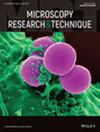Morphological structure of salivary glands, alimentary canal, and Malpighian tubules in adult Eurydema spectabilis Horváth, 1882 (Heteroptera, Pentatomidae)
Abstract
Eurydema spectabilis (Heteroptera: Pentatomidae) has a piercing-sucking mouth type and feeds on plant sap. In this study, the morphological structure of the salivary glands, alimentary canal, and Malpighian tubules of E. spectabilis was examined using light and scanning electron microscopy. Salivary glands consist of the principal and accessory salivary glands. In E. spectabilis, digestion begins in the mouth and ends in the anus. Alimentary canal is divided into three parts: foregut, midgut, and hindgut. The foregut consists of pharynx, esophagus, and proventriculus. The esophagus connects to the proventriculus and resembles a narrow tube. The wall of the proventriculus has a recessed structure and is surrounded by a single cylindrical layer of epithelium and muscle. The midgut is divided into three regions: the first, second, and third ventricles (V1-V3). V1 and V2 consist of single-layered cylindrical epithelium. V3 contains a single layer of cuboidal epithelium. Gastric caeca were found in the midgut. The hindgut consisted of a pylorus followed by a well-developed rectum. The wall of the rectum consists of a single-layer cuboidal epithelium and muscle. Its lumen contains numerous bacteria and uric acid crystals. The pylorus consists of a single-layered cylindrical epithelium. It is also the origin of Malpighian tubules. Malpighian tubules consist of two regions: proximal and distal. The morphological structure of the salivary glands, alimentary canal, and Malpighian tubules of E. spectabilis, which has not been studied before, was examined and discussed in comparison with other orders. It is also aimed to contribute to future studies.
Research Highlights
- In E. spectabilis, the salivary glands are divided into principal and accessory salivary glands.
- Microvilli and numerous secretory granules were found in Malpighian tubules.
- Numerous uric acid crystals and bacteria were found in the rectum lumen.




 求助内容:
求助内容: 应助结果提醒方式:
应助结果提醒方式:


